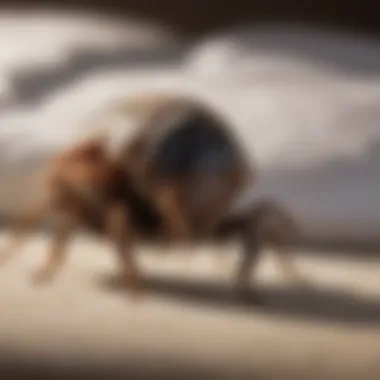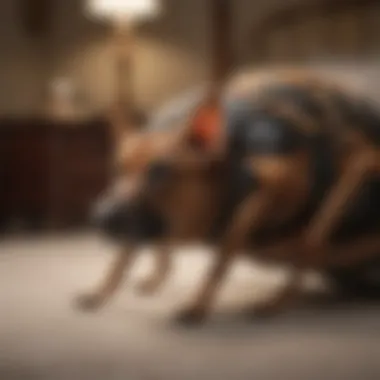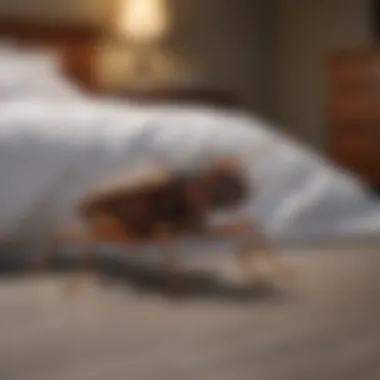K9 Detection: Effective Solutions for Bed Bug Infestations


Intro
Bed bug infestations can disrupt households, causing distress and uncertainty. Their ability to hide in small crevices makes them particularly challenging to locate. Understanding K9 detection offers a promising solution. This canine method uses specially trained dogs to detect bed bugs efficiently. Their acute sense of smell allows them to identify these pests often before they spread further.
Utilizing K9 detection not only facilitates early identification but also helps manage pest control strategies effectively. This article will cover the biology of bed bugs, the detection capabilities of trained dogs, and the significant benefits of utilizing these units as part of a pest management approach.
Pest Identification
Detailed Descriptions of Common Pests
When we talk about pests in the context of bed bugs, we primarily refer to Cimex lectularius. These insects are small, reddish-brown, and nocturnal. Their bodies are flat, allowing them to hide in various places, including mattresses, furniture, and walls. Common signs of bed bug infestations include:
- Visible bugs: Adults are about the size of an apple seed.
- Molts: As they grow, they shed their exoskeletons.
- Fecal spots: Small, dark stains where they have fed.
Signs and Symptoms of Infestations
Infestations often manifest through various signs. Homeowners should be vigilant if they notice:
- Bites: Small, itchy welts on the skin, particularly in a line or cluster.
- Sleepless nights: Anxiety due to bite discomfort and awareness of pests.
- Unpleasant odor: A musty scent caused by the bugs' scent glands.
K9 detection units excel at identifying these signs with accuracy, offering a proactive approach to bed bug management.
Prevention Strategies
Prevention plays a crucial role in managing bed bugs effectively. Here are some essential strategies:
Home Maintenance Tips for Pest Prevention
- Regular cleaning: Vacuum areas where bed bugs naturally hide. Pay special attention to mattresses and upholstery.
- Reduce clutter: Less clutter means fewer hiding spots for pests.
- Seal cracks: Close potential entry points in walls and furniture.
Natural Deterrents and Barriers
Utilizing natural repellents is also beneficial. Essential oils like lavender and tea tree can deter bed bugs. Additionally, encasing mattresses in protective covers lowers the chances of infestation.
Treatment Options
When dealing with an existing infestation, homeowners have various options.
Overview of Chemical vs. Natural Treatments
Chemical treatments are often effective but require caution. In contrast, natural treatments can be gentler on the environment but may take longer to eliminate pests entirely. Both approaches have their pros and cons, and it is essential to chose based on the severity of the infestation and personal preference.
Step-by-step Guides for DIY Treatments
For those who prefer a hands-on approach, here is a simple guide:
- Identify: Confirm the infestation using visual inspections or K9 detection.
- Vacuum: Thoroughly vacuum all infested areas and dispose of the vacuum bag securely.
- Steam clean: Use a steamer on infected surfaces, as heat kills bugs effectively.
- Apply treatment: Choose your preferred chemical or natural spray. Follow instructions carefully.
- Monitor: After treatment, regularly check for signs of resurgence; use K9 detection if needed.
"Early detection and proper treatment are key factors in eradicating bed bugs successfully."
Understanding K9 detection provides insights into proactive pest management. Armed with knowledge, homeowners can make informed decisions regarding treatments and preventative measures.
Preface to Bed Bugs and Their Impact
Bed bugs are small, nocturnal insects that feed on the blood of humans and animals. They are known for their ability to infest homes and other spaces where people gather. Understanding the significance of bed bugs and their impact is crucial for homeowners and housekeepers. These pests not only cause physical discomfort through their bites but can also lead to serious emotional and mental stress.


What Are Bed Bugs?
Bed bugs, scientifically known as Cimex lectularius, are oval-shaped, wingless insects. Adults are typically brown, flatten and range from about 4 to 5 mm in length. They reproduce quickly and are often found in areas like bedding, mattresses, and furniture. Their presence is not limited to dirty environments; even clean spaces can harbor these pests. Bed bugs can survive for months without feeding, making them particularly difficult to eradicate.
Health Risks Associated with Bed Bugs
The most immediate health risk from bed bugs is their bites, which can lead to itchy welts on the skin. While bed bugs are not known to transmit diseases, their bites can cause allergic reactions in some individuals, and scratching can lead to secondary bacterial infections. Furthermore, the anxiety and distress caused by an infestation can have longer-lasting psychological effects. Individuals may experience insomnia or anxiety stemming from the fear of being bitten. The need to maintain a pest-free living environment is paramount.
Economic Consequences of Bed Bug Infestations
The economic implications of bed bug infestations are significant. Homeowners may face the costs of professional extermination services, which can be quite high. In addition, there may be costs associated with replacing infested furniture, clothing, and other possessions. In the hospitality industry, a reputation for bed bug infestations can lead to decreased customer trust and loss of business. Employers may also lose productivity if employees face infestations at home. Therefore, understanding how to manage and eliminate bed bugs is not just a matter of comfort, but also a consideration of financial impact.
The Role of K9 Detection in Pest Control
K9 detection serves a significant function in modern pest control, particularly in the context of managing bed bug infestations. The ability of specially trained dogs to detect these pests enhances the efficiency and effectiveness of treatment strategies. Understanding the role of K9 detection allows homeowners to make informed decisions when addressing potential infestations. Such understanding is essential not only for immediate response but also for long-term management of these pests.
Foreword to K9 Detection
The utilization of K9 detection in pest control hinges on the exceptional olfactory capabilities of dogs. A dog's sense of smell is dramatically more acute than that of humans, estimated to be between 10,000 to 100,000 times better. This remarkable ability enables trained dogs to locate bed bugs and their eggs with high precision. K9 detection is not just a novelty; it is a scientifically backed method that is increasingly recognized for its reliability.
How K9 Detection Works
K9 detection involves a series of training protocols tailored to teach dogs how to identify the scent of bed bugs. The process begins with the selection of suitable dogs, typically those with strong drive and curiosity. Next, trainers introduce the dogs to the specific scents of bed bugs through controlled exercises. The dogs learn to alert their handlers by sitting, pointing, or lying down when they detect the target scent. This method permits inspectors to focus their efforts precisely where the infestations lie, leading to quicker and more accurate interventions.
Advantages of Using K9 Detection
K9 detection provides various advantages over traditional pest control methods. Some of these benefits include:
- Enhanced Detection: Dogs can locate bed bugs even in places that may be hidden from human eyes, such as inside furniture or wall cavities.
- Time Efficiency: Homeowners save time as K9 units can assess a property much faster than human inspectors.
- Non-Invasive Inspection: The method is less disruptive to occupants, as dogs can perform their work with minimal intrusion.
- Improved Accuracy: K9 detection reduces the chances of false positives found in visual inspections, leading to more effective pest management strategies.
Studies have shown that K9 detection can achieve accuracy rates as high as 95% in identifying bed bug infestations, signifying a substantial advancement in pest control efficacy.
Training Protocols for K9 Bed Bug Detection
Training protocols are crucial in ensuring that K9s are effective in detecting bed bugs. These protocols combine science, proper methodology, and commitment from trainers and handlers. When dogs are trained effectively, they become a reliable part of pest control strategies. The process of training not only improves detection capabilities but also enhances the accuracy of inspections. It is vital for pest management professionals to understand these protocols for successful results.
Selection of K9s for Detection Work
Choosing the right dog for bed bug detection is the first step in the training process. Certain breeds, such as Beagles and Labrador Retrievers, are commonly favored due to their strong sense of smell and excellent trainability.
When selecting a K9, consider the following factors:
- Temperament: The dog's personality should be calm and focused.
- Age: Younger dogs often adapt better to training processes.
- Health: Ensure the dog is physically fit for the demands of detection work.
- Drive: A high prey drive can be beneficial for detection tasks.
Using the right breed ensures that the dog can perform under various conditions. This selection creates a solid foundation for the next phase of training.
Basic Training Techniques
In the basic training phase, K9s learn to recognize the scent of bed bugs and their odors. This period involves fundamental techniques that shape their ability to detect the unwanted pests.
Key training methods include:
- Scent Association: Dogs are exposed to live bed bugs or samples. They learn to associate the scent with rewards, such as treats or playtime.
- Obedience Training: Basic commands must be instilled to ensure the dog listens to its handler at all times.
- Search Exercises: Controlled environments are set up where dogs practice finding the scent in various locations.
The effectiveness of these techniques relies on consistency, repetition, and positive reinforcement. Trainers must adapt their methods to suit each dog's unique learning style.
Advanced Training and Certifications


Once the K9 has mastered basic skills, advanced training intensifies the dog's detection abilities. Advanced protocols often include more complex scenarios, enabling the dog to locate bed bugs in various environments.
At this stage, several elements are essential:
- Scenario-Based Training: Dogs are trained in real-world situations, such as hotels or homes, which helps them adjust to different settings.
- Continuous Learning: Experienced trainers provide ongoing training to keep skills sharp.
- Certification Programs: Many organizations offer certification that validates the dog's detection capabilities. Having certified K9 units enhances credibility in pest management.
Obtaining certification also assures clients that the K9 detection team adheres to established industry standards. This professional recognition can be a significant advantage in the pest control market.
"Proper training and selection are essential to maximize the effectiveness of K9 detection in managing bed bug infestations."
Effectiveness of K9 Detection
Understanding the effectiveness of K9 detection in bed bug infestations is crucial for homeowners and pest control professionals. Dogs trained to detect bed bugs offer unique advantages over traditional methods. Their keen sense of smell allows them to identify infestations with a high degree of accuracy. This capability can lead to quicker responses and more effective treatments. By exploring the accuracy, case studies, and limitations of K9 inspections, readers can better appreciate the role these canines play in pest management.
Accuracy Compared to Traditional Methods
K9 detection has shown notable accuracy improvements compared to traditional inspection methods. A skilled detection dog can identify bed bugs and their eggs with precision, often in areas that humans would overlook. Human inspectors typically rely on visual cues and sometimes invasive tactics, which can be labor-intensive. In contrast, K9s can locate bed bugs simply by scent, enabling them to inspect multiple locations efficiently.
Research shows that K9 teams can detect bed bugs with an accuracy rate of up to 96%. This contrasts sharply with traditional inspections, which frequently yield false positives. The ability of dogs to discern scents at low concentrations allows them to locate hidden infestations before they spread. This method not only saves time but also minimizes the costs associated with extensive pest treatment plans.
Case Studies Demonstrating K9 Success
Several real-world examples illustrate the success of K9 detection in managing bed bug infestations. In one notable case, a hotel experienced multiple complaints from guests regarding bed bugs. The management hired a K9 detection team to conduct a thorough inspection. The dogs identified multiple hidden infestations in rooms that had not been checked by human inspectors. Prompt action was taken to treat the affected areas, leading to a swift resolution of the problem and improved guest satisfaction.
Another example comes from a university housing facility. After implementing K9 inspections, the facility observed a drastic decrease in bed bug reports. The comprehensive nature of dog inspections helped in early intervention, thereby preventing larger outbreaks. These case studies underscore the effectiveness and reliability of K9 teams in identifying and mitigating bed bug issues.
Limitations of K9 Inspections
Despite the advantages, K9 detection is not without limitations. Firstly, the success of a K9 inspection heavily relies on the proficiency of the dog and the handler. A poorly trained dog may yield inaccurate results, leading to misconceptions about the extent of an infestation.
Additionally, certain environmental factors can hinder a dog's performance. Odors from strong cleaning agents, air fresheners, or large crowds can distract dogs during their search. Furthermore, limitations in the dog's detection range can affect inspection outcomes, requiring regular training to maintain effectiveness.
Cost can also be a factor. Hiring trained K9 teams may involve a higher upfront investment compared to traditional inspection methods. However, when considering the long-term benefits and potential cost savings from early detection, the investment often pays off.
Integrating K9 Detection into Pest Management Strategies
Integrating K9 detection into pest management strategies is a significant aspect of modern pest control. The need for effective solutions against bed bug infestations has increased, highlighting the importance of various methods. In this context, K9 detection serves as a critical tool that complements traditional pest control practices. Using trained dogs can provide a more precise location of infestations, making eradication efforts more efficient and targeted.
Collaborating with Pest Control Professionals
Collaboration between homeowners and pest control professionals is crucial when integrating K9 detection. Pest control experts can assess the extent of an infestation and determine the necessary steps for treatment. Working with a professional ensures that the K9 unit used is properly trained and certified in detecting bed bugs. Additionally, these professionals can interpret detection results and recommend appropriate follow-up actions. For instance, if a K9 indicates positive detection, the pest control team can undertake targeted treatment, reducing both time and costs.
Determining Inspection Frequency and Protocols
Establishing a clear inspection frequency and protocols is essential for effective pest management. The frequency can depend on several factors, including the severity of previous infestations and environmental conditions. Affected areas may require more frequent inspections, while low-risk zones can have extended intervals. Protocols should clearly outline when and how inspections will occur. These protocols can help maintain a consistent approach to detection and treatment, ensuring that no potential infestations are overlooked. Regularly scheduled inspections build a proactive stance against bed bugs, significantly lowering the risk of widespread infestations.
Developing a Comprehensive Management Plan
A comprehensive management plan is essential for long-term pest control success. This plan should encompass all facets of dealing with bed bug infestations, from K9 detection to treatment and prevention strategies. Key components might include:
- Assessment of Current Infestation: Determine the severity and specific locations of bed bugs.
- Detection Schedule: Outline the frequency of inspections using K9 units.
- Treatment Options: Explore different methods for eradicating bed bugs, including chemical and non-chemical solutions.
- Follow-Up Plans: Develop steps to monitor the effectiveness of treatments and further inspections.
By incorporating K9 detection into this plan, homeowners can ensure that they are taking a comprehensive approach to pest management. This broad strategy allows for adjustments based on detection results and can adapt to changing circumstances.
Integrating K9 detection provides an opportunity to enhance bed bug management significantly. By collaborating with professionals, setting clear inspection protocols, and developing thorough management plans, homeowners can effectively control and prevent bed bug infestations.
Ethical Considerations in K9 Detection


When integrating K9 detection into pest management practices, it is crucial to address the ethical considerations surrounding the use of detection dogs. This section discusses the importance of ensuring that these animals are treated humanely and regarding the precision of the information they provide.
Welfare of Detection Dogs
An essential component of ethical K9 detection practices is the welfare of the dogs involved. Detection dogs, like any working animals, deserve to be cared for properly and to experience a good quality of life. Their training and working conditions should focus on their health and well-being.
To ensure good welfare, handlers must:
- Regularly assess the dog's physical health and emotional state.
- Provide adequate rest periods during inspections to prevent fatigue.
- Use positive reinforcement methods during training rather than harsh techniques.
Ensuring the dogs are well-cared for not only promotes their happiness but also enhances their performance in detecting bed bugs. Healthy dogs are more alert and can more effectively identify infestations. Engaging in ethical practices also fosters public trust, making clients more likely to choose K9 detection services.
Transparency in Reporting Results
Transparency is another critical ethical aspect in K9 detection for bed bugs. It is necessary for pest control professionals to communicate their findings clearly and honestly. This includes sharing the success rates of K9 detection, the limitations of the method, and any uncertainties in the reported results.
Clients deserve to understand the basis on which conclusions are drawn. Here are some key points to ensure transparency:
- Provide a detailed report of findings, including conditions that could have influenced results.
- Disclose any potential biases or limitations of the detection process.
- Ensure that any recommendations made based on K9 findings are appropriate and justified.
Being transparent also carries advantages for pest management companies. It reduces the likelihood of misunderstandings and can strengthen the relationships between clients and service providers. In this way, an ethical approach not only benefits the dogs involved but also leads to better outcomes for homeowners and pest control professionals alike.
"Ethical considerations are paramount in maintaining the integrity of K9 detection services and ensuring the safety and well-being of all parties involved."
By prioritizing the welfare of detection dogs and maintaining transparency in reporting, pest control professionals can ensure that K9 detection remains a credible and effective tool in the fight against bed bugs.
Future of K9 Detection in Pest Control
The future of K9 detection in pest control is promising, combining advancements in training methods with technological innovations. As bed bug infestations become more prevalent, there is an increasing need for effective detection tools. K9 units offer a precise method for locating these pests, and their integration into pest management strategies could be crucial in addressing and mitigating infestations.
One of the significant benefits of K9 detection lies in its efficiency. Trained dogs can detect bed bugs faster than traditional inspection methods. This speed allows property owners to respond more quickly to infestations, ultimately reducing health risks and economic losses. Moreover, as the industry recognizes the effectiveness of these methods, more pest control companies are likely to adopt K9 units into their regular service offerings.
Furthermore, regulations in pest management continue to evolve. There is a push for more environmentally friendly practices, and K9 detection aligns well with these trends. Using these trained dogs can minimize the need for harsh chemicals, making both homes and environments safer. The ability to locate infestations before they spread also aligns with proactive pest management strategies, increasing the overall effectiveness of interventions.
Innovations in K9 Training and Technology
Innovations in K9 training techniques are continuously enhancing the field of pest control. The latest training protocols incorporate both classical and operant conditioning methods, resulting in more reliable detection capabilities. Special focus is placed on familiarizing dogs with bed bug scents in various environments to ensure optimal performance under different conditions.
Technology also plays a critical role. Devices such as odor-detection equipment paired with K9 teams can provide real-time data on detected infestations. This combination between dog ability and technology allows for better documentation and tracking of pest presence, which is crucial for pest control professionals and homeowners alike. New technology ensures that detection efforts are more efficient and that detection dogs can better perform in challenging situations.
Potential for Broader Applications
The potential for broader applications of K9 detection extends beyond just bed bugs. Various pests can be detected using similar principles, allowing trained dogs to assist in identifying rodents, termites, and other harmful critters. This can significantly enhance integrated pest management strategies.
In various sectors, from hospitality to healthcare, K9 units can serve as an essential resource. Proactively identifying infestations ensures timely interventions, safeguarding both people and property. For instance, hotels that employ these services can maintain their reputation while providing guests with pest-free accommodations. Likewise, healthcare facilities can focus on maintaining sanitary environments, protecting patient health.
"As K9 detection evolves, its role in pest management will likely expand, offering innovative solutions to diverse pest-related challenges."
In summary, the future of K9 detection in pest control is poised to shape the industry by improving detection accuracy, promoting eco-friendly practices, and expanding applications to address various pest concerns effectively. This forward-thinking approach strengthens the relationship between traditional pest control methods and modern advancements.
Closure
The conclusion of this article serves to encapsulate the vital aspects of K9 detection for bed bug infestations. This innovative approach offers significant advantages over traditional pest control methods. It’s essential to recognize how K9 units function not only effectively but also efficiently in identifying bed bugs. They utilize their acute sense of smell to detect even the slightest presence of a bug and its eggs, which is crucial, as early detection can prevent extensive infestations and costly treatments.
Summary of Key Points
In summary, the key points highlighted throughout the article include:
- Understanding Bed Bugs: Knowledge of bed bugs, their habits, and health risks they pose.
- Role of K9 Detection: A clear comprehension of how specially trained dogs contribute to effective pest management.
- Training Protocols: Insight into how dogs are selected and trained for this specialized work.
- Effectiveness: Comparison of K9 detection to traditional methodologies, underscoring its superior accuracy.
- Ethics and Future: Consideration of the welfare of detection dogs and potential advancements in training and application.
Final Thoughts on K9 Detection
In essence, K9 detection represents a significant leap forward in pest control strategies. As bed bug infestations grow more common, the integration of K9 teams into regular pest management plans becomes increasingly vital. Their specialized skills streamline the inspection process, making them an indispensable tool for homeowners and pest control professionals alike. With continued advancements in training and technology, the future of K9 detection is promising and holds potential for broader applications beyond bed bugs. Adoption of such methods not only ensures enhanced detection but also fosters a proactive approach to pest management.



